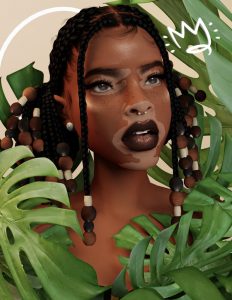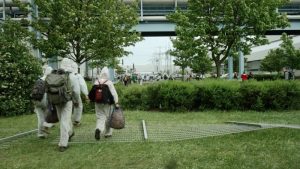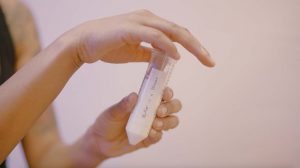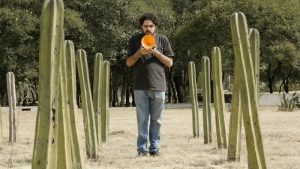On Monday i woke up convinced that it would be a good idea to go to the Guggenheim museum and see Cai Guo-Qiang solo show, I Want To Believe. Right from the entrance, i had the suspicion that my brain might not be at its most powerful before 2 pm. What? $18 for an entry? The problem is not that i have to fork them out of my pocket (with the dollar so weak it feels like playing monopoly here) but it is really hard to resist the urge of making any sneaky comment about the consequences of turning culture into a luxury good that only European tourists can afford (didn’t seem to be anyone speaking like a New Yorker when i was there). Oh! Well, there! I spat my comment.
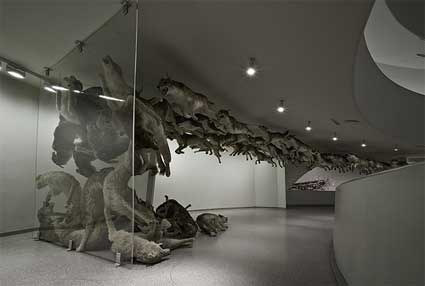 Head On, 2006. Photo by David Heald
Head On, 2006. Photo by David Heald
I was very curious to see the installation Head On, 99 life-sized plush wolves hurling themselves in a neat row towards and right into a glass panel. That one was almost ok-ish when seen up close but it gained some awe-inspiring power when viewed from afar. The way the row of wolves played with the spiraling architecture designed by Frank Lloyd Wright was pure pleasure. Unfortunately i was not allowed to take any picture and the choice of images from the press kit is a bit lame so you’ll have to take my word for it.
The pièce de résistance was Inopportune: Stage One, nine cars, some of which are suspended from the top of the rotunda, are pierced with blinking light tubes. The installation simulates the freeze-frame trajectory of a car-bomb explosion through the atrium’s void. Now that makes for a very nice poster or postcard. It is impressive in all its flashiness but not very elegant nor particularly interesting.
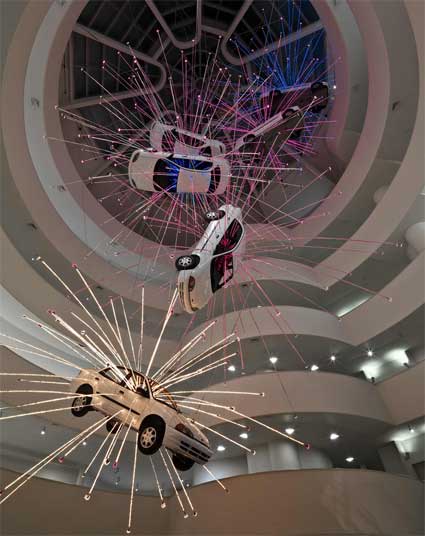 Inopportune: Stage One, 2004. Photo by David Heald.
Inopportune: Stage One, 2004. Photo by David Heald.
More stuffed animals. This time tigers pierced by arrows. Your little nephew would certainly like that one.
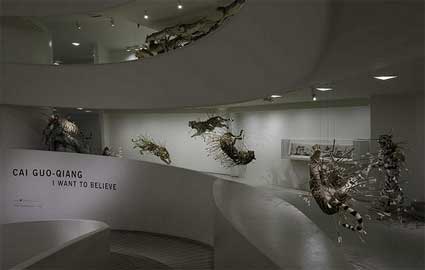 Inopportune: Stage Two, 2004. Photo by David Heald
Inopportune: Stage Two, 2004. Photo by David Heald
Now there were some artworks which made me happy. Very happy. Such as the re-staging of Venice’s Rent Collection Courtyard, Golden Lion Award at the Venice Biennale in 1999.
The original Rent Collection Courtyard is one of the best-known propaganda works of the Cultural Revolution. The tableau of more than a hundred life-size clay figures was created in 1965 to depict the oppression of peasants by a cruel landlord in pre-Communist China. Copies were exhibited throughout the country during the Cultural Revolution.
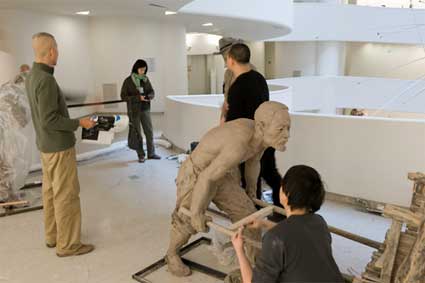 One of the guest artisans models clay of one of the figures in the early stages of the installation as Cai Guo-Qiang (left) looks on (image Guggenheim)
One of the guest artisans models clay of one of the figures in the early stages of the installation as Cai Guo-Qiang (left) looks on (image Guggenheim)
10 artisans from China worked on-site during the first two weeks of the Guggenheim exhibit, modeling the 70 life-size clay figures of the New York’s Rent Collection Courtyard (2008). The sculptures are intentionally left unfired, and over time, the clay will crumble.
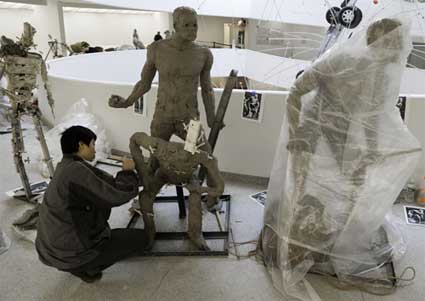 Images of the original 1965 figures are taped to the ramp walls to serve as references from which the artisans worked (image Gugenheim)
Images of the original 1965 figures are taped to the ramp walls to serve as references from which the artisans worked (image Gugenheim)
After the conclusion of the New York retrospective, “Rent Collection Courtyard” will travel with to the Guggenheim Bilbao. However, this installation will not appear in the exhibition’s intermediate stop in Beijing during the summer Olympics.
“There are a lot of paintings that make fun of Mao, like putting flowers on his head or making a female version,” Cai said. Those works can be exhibited in China. But the Rent Collection Courtyard’ is still forbidden in China. That implies there is a power in it, people don’t want to touch the tragedy or the historical scar. You will offend a lot of people. That is the charm of it, and that is why I wanted to do it. Although the work can’t be shown in China, people in China pay a great deal of attention to it. Probably when one day the work can be shown in Beijing, I won’t want to do that.”
(via)
At the time of the Venice Biennale, the Chinese press raised the issue of appropriation and intellectual copyright and covered the political controversy raised by the widespread belief that Cai was attacking his homeland. A copyright infringement lawsuit against Cai and the Venice Biennale was filed in China by sculptors who participated in creating the original work, but the case was dismissed by the courts.
Actually the more i get back in time, the more i am seduced by the artist’s work. Particularly by his pyromaniac performances.
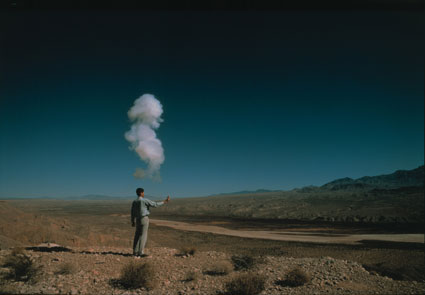 The Century with Mushroom Clouds: Project for the 20th Century, 1996 (Nevada Test Site). Photo by Hiro Ihara, courtesy Cai Studio
The Century with Mushroom Clouds: Project for the 20th Century, 1996 (Nevada Test Site). Photo by Hiro Ihara, courtesy Cai Studio
According to Cai, “As a symbol of the progress and victory of science, the ‘mushroom clouds,’ with all their visual impact, have a tremendous material and spiritual influence on human society.” Documented through photos and video, The Century with Mushroom Clouds: Project for the 20th Century is a series of miniature “mushroom cloud” explosions realized at symbolic locations in the United States to “depict the ‘face’ of the nuclear bomb that represents modern-day technology.”
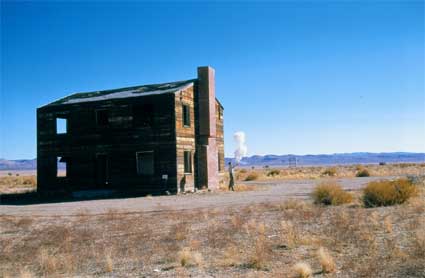 The Century with Mushroom Clouds: Project for the 20th Century, 1996 (Nevada Test Site). Photo by Hiro Ihara, courtesy Cai Studio
The Century with Mushroom Clouds: Project for the 20th Century, 1996 (Nevada Test Site). Photo by Hiro Ihara, courtesy Cai Studio
The project employed gunpowder placed in small cardboard tubes. Cai detonated the explosions by hand at various locations, including the Nevada Test Site (used for explosive nuclear-weapons tests between 1951 and 1992), Michael Heizer‘s earthwork Double Negative (1969-70) also in Nevada, and Robert Smithson’s earthwork Spiral Jetty (1970) on the Great Salt Lake in Utah.
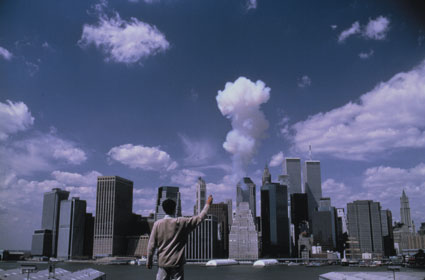 The Century with Mushroom Clouds: Project for the 20th Century, 1996 (Manhattan). Photo by Hiro Ihara, courtesy Cai Studio
The Century with Mushroom Clouds: Project for the 20th Century, 1996 (Manhattan). Photo by Hiro Ihara, courtesy Cai Studio
Cai also detonated gunpowder with the skyline of Manhattan in the background.
The Fetus Movement II: Project for Extraterrestrials explosion brought feng shui to the Bundeswehr-Wasser Ubungsplatz military base in Germany. At the site, gunpowder fuse was arranged on the ground in three concentric circles and eight transverse lines to resemble markings for latitude and longitude. To incorporate the feng shui principle that “running water does not rot”, water was diverted from a nearby river into a canal composing the outermost circle.
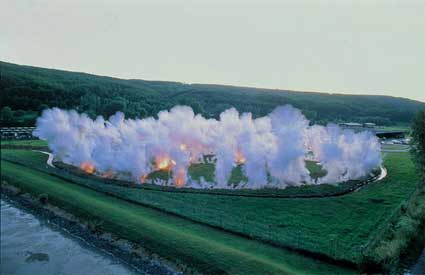 Fetus Movement II: Project for Extraterrestrials No. 9, 1992. Photo by Masanobu Moriyama, courtesy Cai Studio
Fetus Movement II: Project for Extraterrestrials No. 9, 1992. Photo by Masanobu Moriyama, courtesy Cai Studio
Cai positioned himself in the middle on a tiny circular island surrounded by a second canal of river water. He was connected to an electrocardiograph and an electroencephalograph to monitor his heart and brainwaves during the explosion. Sensors were buried around the outside perimeter of the outer circle and attached to a seismograph on the island to simultaneously chart the movement of the earth. A composite print documents the results taken from each instrument before, during, and after the explosion, quantifying the inextricable relationship between man, the earth, and the universe. Video.
Cai Guo-Qiang: “I Want to Believe,” runs through May 28, 2008, at the Guggenheim Museum in New York.

